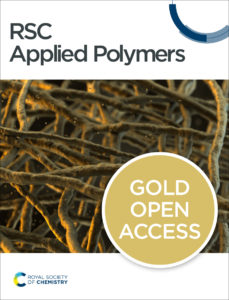
To celebrate the growth and development of the RSC Applied Polymers community and to highlight the remarkable authors who continue to contribute their high quality work to the journal, we would like to share the opinions and insights of these authors through this introductory blog post. Once dubbed #RSCAppliedfirst50, our blog posts aim to give a voice to the authors behind the research and hope that their insights might shed light upon growing challenges and progress in polymer science and its applications.
In this edition, we hear from Shixue Ren about their article entitled ‘Optimization of light-curing ionogels by response surface methodology‘.
An interview with Shixue Ren
Where do you see your own research going in future?
Since their initial report, ionogels have attracted significant research interest due to their remarkable properties, which show great potential in applications such as sensors and actuators. In the preparation of polymeric materials, crosslinkers play a vital role. However, we noticed a lack of crosslinkers derived from natural products. We are particularly excited to have developed a method to modify natural compounds, leading to the synthesis of a novel bio-based crosslinker.
Looking forward, we plan to explore the broader applicability of this crosslinker. A key focus will be investigating the synergistic mechanisms between dynamic covalent and non-covalent bonds. This will enable the development of bio-based ionogels with intelligent functionalities, such as self-healing, shape memory, and reconfigurability. With the growing momentum of additive manufacturing, we also aim to leverage the photo-curing properties of these materials to establish high-resolution printing techniques for ionogels. This would allow us to fabricate complex architectures and, by integrating 4D printing concepts, achieve programmable shape transformations in response to environmental stimuli.
What aspects of this research excite you the most?
Nature is our greatest source of inspiration. In our earlier research, we took notice of rutin—a natural flavonoid glycoside—recognizing its inherent potential to serve as an excellent crosslinker. What truly excites me is that this hypothesis was experimentally validated: we successfully transformed rutin, a biomass-derived natural molecule, into a structural building block for high-performance ionogels through green chemical modification. This approach led to a synergistic enhancement of both mechanical properties and functional attributes such as UV shielding and adhesion, underscoring the broader application potential of natural products.
While conventional ionogel studies often emphasize conductivity or mechanical performance, our work goes further. Not only have we improved the mechanical properties of the ionogel, but we have also effectively “inherited” the intrinsic UV-blocking capability of natural rutin into the gel matrix. This resulted in a material capable of blocking over 99% of UVB radiation while maintaining high visible-light transmittance. This suggests that, beyond flexible electronics and wearable devices, such materials could be applied as transparent anti-UV coatings in areas like construction materials and automotive glass—truly embodying the concept of “one material, multiple functions.”
What excites me the most is that we are redefining the design logic for high-performance polymeric materials by drawing inspiration from the “intelligent architecture” of natural molecules. Instead of relying on complex synthesis from petroleum-based monomers, we are pursuing functional modification of biomass to achieve a unified combination of performance, functionality, and sustainability. Rutin, as a natural polyphenol, has been conventionally used in pharmaceuticals or nutritional supplements. Through esterification, however, we converted it into a crosslinker bearing multiple photo-curable sites, effectively turning it into a “molecular hub” for constructing three-dimensional polymer networks. This strategy—elevating biomass molecules from mere “additives” to “structural protagonists”—establishes a new paradigm for developing future bio-based functional materials.
In your opinion, what are the most important questions to be asked/answered in your field of research?
In the interdisciplinary field of photo-curable ionogels and biomass-derived polymer materials, the most fundamental and pressing question is this: How can we develop green and sustainable molecular design strategies that not only preserve the high conductivity, stability, and processability of ionogels, but also enable a synergistic enhancement of their mechanical properties, functional integration, and environmental friendliness?
While we have achieved excellent results using naturally-derived crosslinkers in ionic liquids, it must be acknowledged that—like most high-performance ionogels—our research remains at the laboratory scale. There is still a considerable distance to travel in developing low-energy, solvent-free, and continuous photo-curing processes compatible with existing industrial systems. Furthermore, although we have emphasized the bio-based origin and UV-shielding performance of the material, critical questions regarding its long-term environmental stability, biodegradability, and pathways for recycling or reuse have not yet been systematically investigated. These issues must be thoroughly addressed before the material can progress toward practical application.
Meet the authors

Dejun Peng
Dejun Peng is a doctoral student at Northeast Forestry University, working under the guidance of Dr. Shixue Ren. He obtained his bachelor’s degree from Northeast Forestry University in 2025. His research focuses on the high-value utilization of biomass polyphenols.

Zeyu Zhang
Zeyu Zhang earned her master’s degree from Beihua University in 2022. She is currently a fourth-year Ph.D. candidate at Northeast Forestry University. Her research focuses on soft materials, particularly biomass elastomers and ionogels.

Shixue Ren
Shixue Ren is professor of Northeast Forestry University. His research focuses on the structural analysis, degradation mechanism and chemical modification paths, high-value utilization technologies and structure-activity relationship research of plant polyphenols, lignin, etc.
Optimization of light-curing ionogels by response surface methodology
Dejun Peng, Zeyu Zhang, Xueyan Shang, Jiguo Zhang and Shixue Ren
RSC Appl. Polym., 2025, 3, 1366-1375. DOI: 10.1039/D4LP00381K


RSC Applied Polymers is a leading international journal for the application of polymers, including experimental and computational studies on both natural and synthetic systems. In this journal, you can discover cross-disciplinary scientific research that leverages polymeric materials in a range of applications. This includes high impact advances made possible with polymers across materials, biology, energy applications and beyond.

